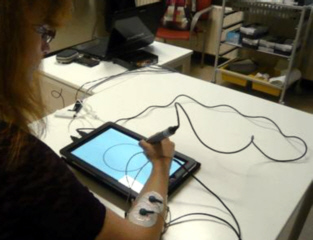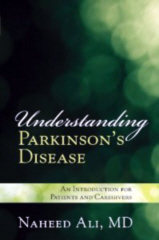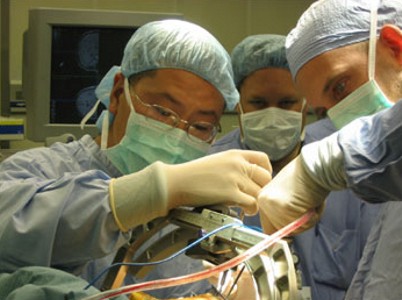7th October 2013 - New researc
h
Parkinsonism Related Disorders [2013] Sep 5 [Epub ahead of print] (R.Pahwa, K.E.Lyons, R.A.Hauser, S.Fahn, J.Jankovic, E.Pourcher, A.Hsu, M.O'Connell, S.Kell, S.Gupta)
L-dopa usually comes in two different formats : either the immediate release version, which satisfies the immediate need for L-dopa, or the controlled release version, which avoids the excessive effects of L-dopa by spreading out the effect over time. Dual layer L-dopa (IPX066), which is being developed for the treatment of Parkinson's Disease, has the advantages of both by combining the two types of L-dopa.
A randomized, double-blind, placebo-controlled, clinical trial of IPX066 assessed three dosages of L-dopa : 145mg, 245mg or 390mg taken three times daily. The main efficacy measure was the Parkinson's Disease symptom score, the Unified Parkinson's Disease Rating Scale (UPDRS), and also the Parkinson's Disease Questionnaire (PDQ-39).

All three dosages improved Parkinson's Disease, with the 145mg dosage, then the 245mg dosage giving better results. The most commonly reported adverse events with IPX066 included nausea, dizziness, and headache. No unexpected drug-related serious adverse events were reported.


















 They took 40mg pimavanserin per day. The primary measure was the antipsychotic benefit using the Parkinson's disease-adapted scale for assessment of positive symptoms (SAPS-PD). According to the Parkinson's disease-adapted scale for assessment of positive symptoms (SAPS-PD) those people taking pimavanserin reduced their score by 5.79 compared with a reduction of 2.73 by those taking a placebo. Over 10% of the patients discontinued because of an adverse event. However, in previous clinical trials there was either no effect or it was beneficial for some but not all measures of psychosis
They took 40mg pimavanserin per day. The primary measure was the antipsychotic benefit using the Parkinson's disease-adapted scale for assessment of positive symptoms (SAPS-PD). According to the Parkinson's disease-adapted scale for assessment of positive symptoms (SAPS-PD) those people taking pimavanserin reduced their score by 5.79 compared with a reduction of 2.73 by those taking a placebo. Over 10% of the patients discontinued because of an adverse event. However, in previous clinical trials there was either no effect or it was beneficial for some but not all measures of psychosis Fewer p
Fewer p
 The system’s software records key features regarding the movement of the pen, relating it to the motion of the limb, particularly the role of the hand and fingers in coordinating overall pen motion. The recordings enable the operator to assess akinesia, bradykinesia, tremor, rigidity and other signs of motor deterioration that cannot be easily detected by other means. The software takes inputs from a variety of sensors in the pen and converts them, using proprietary algorithms, into outcome percentages that represent the likelihood of the presence of Parkinson's Disease or other neuromotor disorders.
The system’s software records key features regarding the movement of the pen, relating it to the motion of the limb, particularly the role of the hand and fingers in coordinating overall pen motion. The recordings enable the operator to assess akinesia, bradykinesia, tremor, rigidity and other signs of motor deterioration that cannot be easily detected by other means. The software takes inputs from a variety of sensors in the pen and converts them, using proprietary algorithms, into outcome percentages that represent the likelihood of the presence of Parkinson's Disease or other neuromotor disorders.

 Publisher's description : Understanding Parkinson’s Disease offers patients and their caregivers the kind of cutting-edge information that will allow them to successfully confront this debilitating disease on a number of fronts. Patients will also be uniquely exposed to alternative approaches to managing the symptoms of the disease, including allopathic, osteopathic, and naturopathic approaches. The reader will be introduced to essential information on the risk factors associated with Parkinson’s, the signs and symptoms, the different stages of the disease, the various treatments, as well as how the disease develops.
Publisher's description : Understanding Parkinson’s Disease offers patients and their caregivers the kind of cutting-edge information that will allow them to successfully confront this debilitating disease on a number of fronts. Patients will also be uniquely exposed to alternative approaches to managing the symptoms of the disease, including allopathic, osteopathic, and naturopathic approaches. The reader will be introduced to essential information on the risk factors associated with Parkinson’s, the signs and symptoms, the different stages of the disease, the various treatments, as well as how the disease develops. 






 They had an average of two additional medical disorders with arthritis (49%) and heart problems (32%) being the most common. Most of them (87%) took at least 2 medications, with L-dopa (96%), dopamine agonists (45%) and antidepressants (37%) being the most common. Most of them were not currently utilizing physical, occupational or speech therapy, but two-thirds of them reported engaging in physical activity. Deep brain stimulation was documented in 22%. Overall the mean health-related quality of life and caregiver burden was impaired in all domains.
They had an average of two additional medical disorders with arthritis (49%) and heart problems (32%) being the most common. Most of them (87%) took at least 2 medications, with L-dopa (96%), dopamine agonists (45%) and antidepressants (37%) being the most common. Most of them were not currently utilizing physical, occupational or speech therapy, but two-thirds of them reported engaging in physical activity. Deep brain stimulation was documented in 22%. Overall the mean health-related quality of life and caregiver burden was impaired in all domains. Researchers examined the association between the intake of caffeine and the time taken to develop dyskinesia. Those people who consumed 12 ounces of coffee per day, which is about two cups, reduced their likelihood of developing dyskinesia to 61%. Those people who consumed 4 to 12 ounces of coffee per day, which is less than two cups per day, reduced their likelihood of developing dyskinesia to 73%. The authors suggest tha these results support the possibility that caffeine may reduce the likelihood of developing dyskinesia.
Researchers examined the association between the intake of caffeine and the time taken to develop dyskinesia. Those people who consumed 12 ounces of coffee per day, which is about two cups, reduced their likelihood of developing dyskinesia to 61%. Those people who consumed 4 to 12 ounces of coffee per day, which is less than two cups per day, reduced their likelihood of developing dyskinesia to 73%. The authors suggest tha these results support the possibility that caffeine may reduce the likelihood of developing dyskinesia. The 70 year old
The 70 year old 